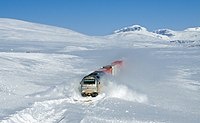
Photo from wikipedia
Abstract. The partition of cloud and drizzle water path in precipitating clouds plays a key role in determining the cloud lifetime and its evolution. A technique to quantify cloud and drizzle water… Click to show full abstract
Abstract. The partition of cloud and drizzle water path in precipitating clouds plays a key role in determining the cloud lifetime and its evolution. A technique to quantify cloud and drizzle water path by combining measurements from a three-channel microwave radiometer (23.8, 30, and 90 GHz ) with those from a vertically pointing Doppler cloud radar and a ceilometer is presented. The technique is showcased using 1 d of observations to derive precipitable water vapor, liquid water path, cloud water path, drizzle water path below the cloud base, and drizzle water path above the cloud base in precipitating stratocumulus clouds. The resulting cloud and drizzle water path within the cloud are in good qualitative agreement with the information extracted from the radar Doppler spectra. The technique is then applied to 10 d each of precipitating closed and open cellular marine stratocumuli. In the closed-cell systems only ∼20 % of the available drizzle in the cloud falls below the cloud base, compared to ∼40 % in the open-cell systems. In closed-cell systems precipitation is associated with radiative cooling at the cloud top - 100 W m - 2 and a liquid water path >200 g m−2 . However, drizzle in the cloud begins to exist at weak radiative cooling and liquid water path > ∼ 150 g m−2 . Our results collectively demonstrate that neglecting scattering effects for frequencies at and above 90 GHz leads to overestimation of the total liquid water path of about 10 %–15 %, while their inclusion paves the path for retrieving drizzle properties within the cloud.
Journal Title: Atmospheric Measurement Techniques
Year Published: 2020
Link to full text (if available)
Share on Social Media: Sign Up to like & get
recommendations!